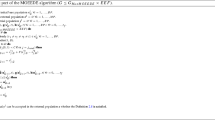Abstract
This paper describes a new evolutionary methodology aimed at optimizing various and heterogeneous data in common evolution. The representation of solutions uses mixed-integer genotypes and variable-length chromosomes to face a complex problem of task decomposition and high-level control generation. A memory operator is introduced to face convergency uncertainties issued from the irregularities of both discontinuous evaluation function and heterogeneous solution representation. The stability of the evolutionary algorithm is analyzed with dimension changes in the optimization problem.
Similar content being viewed by others
References
Al-Olimat, K. and Ghandakly, A.: Using multiple identification models in adaptive power system stabilizers, in: North American Power Symposium (NAPS), Cleveland, 1998.
Ban, A. and Mayer, H.: Experimental analysis of evolutionary algorithms using chromosomes of variable length, in: PS Natural Computation, SS’2003, 2003.
Chocron, O. and Bidaud, P.: Genetic design of 3D modular manipulators, in: Proc. of ICRA’97, Internat. Conf. on Robotics and Automation, 1997.
Eucker, R. J. and Gao, Z.: A novel self-tuning control design approach for industrial applications, in: Proc. of Internat. Conf. IAS-6, Venice, Italy, 2000.
Fogel, D. B., Fogel, L. J., and Atmar, J. W.: Meta-evolutionary programming, in: Proc. of the 25th Asilomar Conference on Signals, Systems and Computers, 1991.
Goldberg, D. E.: Genetic Algorithms in Search, Optimization and Machine Learning, Addison-Wesley, Reading, MA, 1989.
Goldberg, D.E., Deb, K., Kargupta, H., and Harik, G.: Rapid, accurate optimization of difficult problems using fast Messy algorithms, in: Proc. of Internat. Conf. on Genetic Algorithms, 1993, pp. 56–64.
Kim, J. O. and Khosla, P.: A multi-population genetic algorithm and its application to design manipulators, in: IROS’98, 1998.
Kubota, N., Arakawa, T., and Fukuda, T.: Trajectory generation for redundant manipulator using virus evolutionary genetic algorithm, in: IEEE Internat. Conf. on Robotics and Automation, Albuquerque, NM, 1997.
Lee, C.-Y. and Antonsson, E. K.: Variable length genomes for evolutionary algorithm, in: Proc. of the Genetic and Evolutionary Computation Conf. GECCO, 2000.
Lian Seng, T., Khalid, M., and Yusef, R.: Tuning of a neuro-fuzzy controller by genetic algorithm, IEEE Trans. Systems Man Cybernet. (1999).
Sakka, S.: Evolutionary control generator for unknown structures, in: Internat. Conf. on Modelling, Identification and Control, MIC 2004, Grindelwald, Switzerland, 2004.
Sakka, S. and Chocron, O.: Optimal design, configurations and positions for a mobile manipulation task using genetic algorithm, in: RoMan’01, IEEE, 2001.
Sakka, S. and M’Sirdi, N. K.: Reliability of optimal evolutionary-based control for a mobile manipulator trajectory following task, in: ISMCR’02, Internat. Symp. on Measurement and Control in Robotics, Bourges, France, 2002.
Seraji, H.: Configuration control of rover-mounted manipulators, in: IEEE Internat. Conf. on Robotics and Automation, Nagoya, Japan, 1995.
Sbarbaro, D. and Murray-Smith, R.: Self-tuning control of non-linear systems using Gaussian process prior models, DCS Technical Report TR-2003-143, Department of Computing Science, Glasgow University, May 2003.
Solteiro Pires, E. J., Tenreiro Machado, J. A., and de Moura Oliveira, P. B.: An evolutionary approach to robot structure and trajectory optimization, in: ICAR’01, 10th Internat. Conf. on Advanced Robotics, Budapest, 2001.
Sprave, J. and Rolf, S.: Variable dimensional optimization with evolutionary algorithms using fixed-length representations, in: 7th Internat. Conf. EP’98, San Diego, CA, 1998.
Tzafestas, S. G.: Adaptive, robust and fuzzy rule-based control of robotic manipulators, J. Intelligent Robotic Systems (1991), 421–457.
Zebulum, R. S., Pacheco, M. A., and Vellasco, M.: Variable length representation in evolutionary electronics, Evolutionary Computation 8(1) (2000), 93–120.
Author information
Authors and Affiliations
Corresponding author
Rights and permissions
About this article
Cite this article
Sakka, S., Coiffet, P. Contribution to Design of Complex Mechatronic Systems. An Approach through Evolutionary Optimization. J Intell Robot Syst 42, 1–25 (2005). https://doi.org/10.1007/s10846-004-3395-7
Received:
Issue Date:
DOI: https://doi.org/10.1007/s10846-004-3395-7




